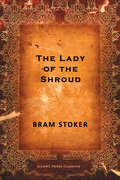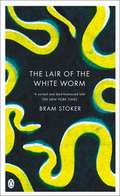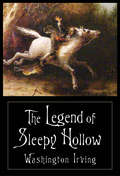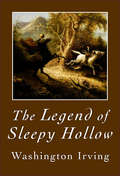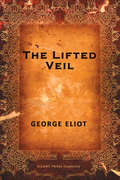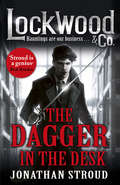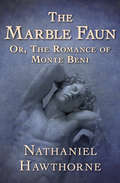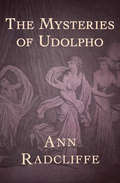- Table View
- List View
The Lady of the Shroud
by Bram StokerThe Lady of the Shroud is a novel by Bram Stoker, published in 1909. The book is an epistolary novel, narrated in the first person via letters and diary extracts from various characters, but mainly Rupert. The initial sections, leading up to the reading of the uncle's will, told by other characters, suggest that Rupert is the black sheep of the family, and the conditions of having to live in the castle in the Blue Mountains for a year before he can permanently inherit the unexpectedly large million-pound estate suggest the uncle is somehow testing the heir. When an unexpected, mysterious women cloaked in a wet shroud appears, she changes Rupert's destiny forever.
The Lair of the White Worm
by Bram StokerAn ancient evil walks among them. When Adam Salton arrives at his grand-uncle's Derbyshire estate he quickly senses that a macabre and malevolent force is at work. In his attempts to uncover the grisly mystery he encounters the chilling Lady Arabella and the obsessive Edgar Caswall, each harbouring their own dark and dreadful desires. To his horror, Adam discovers that something hideous is living in the grounds of nearby Castra Regis, something that feeds on the flesh of humans. And so begins a terrifying quest to destroy the evil lurking in their midst . . .
The Legend of Sleepy Hollow
by Washington IrvingThe Legend of Sleepy Hollow, along with its companion piece, Rip Van Winkle is one of the best-known short stories to have come from America—though written while Irving was living abroad in England. Best enjoyed at Hallowe'en! The story is set in 1790 in the countryside around the Dutch settlement of Tarry Town (historical Tarrytown, New York), in a secluded glen called Sleepy Hollow. Sleepy Hollow is renowned for its ghosts and the haunting atmosphere that pervades the imaginations of its inhabitants and visitors. Some residents say this town was bewitched during the early days of the Dutch settlement. Other residents say an old Native American chief, the wizard of his tribe, held his powwows here before the country was discovered by Master Hendrick Hudson. The most infamous spectre in the Hollow is the Headless Horseman, said to be the ghost of a Hessian trooper that had his head shot off by a stray cannonball during "some nameless battle" of the American Revolutionary War, and who "rides forth to the scene of battle in nightly quest of his head".
The Legend of Sleepy Hollow
by Washington IrvingThe Legend of Sleepy Hollow, along with its companion piece, Rip Van Winkle is one of the best-known short stories to have come from America—though written while Irving was living abroad in England. Best enjoyed at Hallowe'en! The story is set in 1790 in the countryside around the Dutch settlement of Tarry Town (historical Tarrytown, New York), in a secluded glen called Sleepy Hollow. Sleepy Hollow is renowned for its ghosts and the haunting atmosphere that pervades the imaginations of its inhabitants and visitors. Some residents say this town was bewitched during the early days of the Dutch settlement. Other residents say an old Native American chief, the wizard of his tribe, held his powwows here before the country was discovered by Master Hendrick Hudson. The most infamous spectre in the Hollow is the Headless Horseman, said to be the ghost of a Hessian trooper that had his head shot off by a stray cannonball during "some nameless battle" of the American Revolutionary War, and who "rides forth to the scene of battle in nightly quest of his head".
The Lifted Veil
by George EliotQuite unlike the realistic fiction for which Eliot is best known, The Lifted Veil explores themes of extrasensory perception, the essence of physical life, possible life after death, and the power of fate. The novella is a significant part of the Victorian tradition of horror fiction.
Lockwood & Co: The Dagger in the Desk (Lockwood & Co.)
by Jonathan StroudA thrilling new case for London’s most talented psychic detection agency – from the global bestselling author of the Bartimaeus Sequence.In London, a mysterious and potentially deadly ghost is stalking the halls of St Simeon’s Academy for Talented Youngsters. It lurks in the shadows, spreading fear and icy cold – and it carries a sharp and very solid dagger . . .The headmaster wastes no time in enlisting the help of ghost-hunters Anthony Lockwood, Lucy Carlyle and George Cubbins. Can Lockwood & Co. survive the night and save the day?
M (Devil's Advocates)
by Samm DeighanFritz Lang’s first sound feature, M (1931), is one of the earliest serial killer films in cinema history and laid the foundation for future horror movies and thrillers, particularly those with a disturbed killer as protagonist. Peter Lorre’s child killer, Hans Beckert, is presented as monstrous, yet sympathetic, building on themes presented in the earlier German Expressionist horror films like The Cabinet of Dr. Caligari and The Hands of Orlac. Lang eerily foreshadowed the rising fascist horrors in German society, and transforms his cinematic Berlin into a place of urban terror and paranoia. Samm Deighan explores the way Lang uses horror and thriller tropes in M, particularly in terms of how it functions as a bridge between German Expressionism and Hollywood’s growing fixation on sympathetic killers in the ‘40s. The book also examines how Lang made use of developments within in forensic science and the criminal justice system to portray a somewhat realistic serial killer on screen for the first time, at once capturing how society in the ‘30s and ‘40s viewed such individuals and their crimes and shaping how they would be portrayed on screen in the horror films to come.
The Marble Faun: Or, The Romance of Monte Beni
by Nathaniel HawthorneFrom the author of The Scarlet Letter: The thrilling tale of three American artists whose search for artistic inspiration leads to romance and murder. The sculpture galleries and classical architecture of nineteenth-century Rome set the stage for Nathaniel Hawthorne’s gothic romance The Marble Faun. While touring the Eternal City in search of inspiration and authentic beauty, American artists Miriam, Hilda, and Kenyon soon discover that their Italian companion, Donatello—charming and in love with Miriam—bears a striking resemblance to the marble Faun of Praxiteles. But for Miriam, their carefree pursuit is also an escape from a dark past. And when a mysterious man appears, trailing the friends’ path and tormenting Miriam, the group’s travels take a sinister turn. The first novel to explore the effects of European sensibilities on American values, The Marble Faun anticipated the genre of travel novels later exemplified by The Portrait of a Lady by Henry James and The Innocents Abroad by Mark Twain. Vividly evoking the great works of art and architecture in Rome, it also found favor as an unlikely guidebook for many Victorian tourists. James Russell Lowell said: “The nineteenth century has produced no more purely original writer than Mr. Hawthorne.” Here, the author of The House of the Seven Gables offers an unforgettable and suspenseful tale. This ebook has been professionally proofread to ensure accuracy and readability on all devices.
The Masque of the Red Death (Devil's Advocates)
by Steve HabermanThe Masque of the Red Death (1964), the seventh collaboration between producer-director Roger Corman and horror icon Vincent Price, became the crowning achievement for both men, their masterpiece. After the critical and commercial success of House of Usher in 1960, Corman fervently desired to adapt Edgar Allan Poe’s story, ‘The Masque of the Red Death’ as his next project, but the tale took three years to finally become, not Corman’s second Poe film, but his second to last. Its long development benefitted the end result, and the story of its making reveals the persistence and vision of Corman, the artist and entrepreneur of classic horror. In this Devil’s Advocate, Steve Haberman takes an auteurist approach to the film with Corman as the ultimate author of the work. He explores the emergence of Corman’s themes and techniques through directorial control and compares them with the intentions and concerns of the story’s original creator, Poe. In his research, Haberman secured both drafts of the script, the first by Charles Beaumont and the last by R. Wright Campbell, consulted published interviews and met with Corman. The result illuminates not only the film but the profound and profoundly dark world views of both Roger Corman and Edgar Allan Poe.
The Mummy (Devil's Advocates)
by Doris SutherlandReleased in 1932, The Mummy moved Universal horror away from the Gothic Europe of Dracula and Frankenstein and into a land of deserts, pyramids, and long-lost tombs. In doing so the film continued a tradition of horror fiction that is almost as old as the Western pursuit of Egyptology, as numerous European and American authors from the nineteenth and early twentieth centuries had portrayed Egypt as a place of mystery and magic. This book examines the roots of The Mummy. It shows how the film shares many of its motifs with the work of writers such as Bram Stoker, Arthur Conan Doyle, and H. Rider Haggard, whose tales of living mummies, immortal sorcerers, and Egyptian mysticism bear strong resemblances to Universal’s movie. In addition, the book discusses how The Mummy drew upon a contemporary vogue for all things ancient Egyptian: the tomb of Tutankhamun was discovered the decade before the film was released, prompting sensationalistic rumors of a curse. This is the story of what happened when Hollywood horror went to Egypt.
The Mysteries of Udolpho: A Romance
by Ann RadcliffeThe haunting, atmospheric tale that set the standard for the Gothic novel Emily St. Aubert leads a simple and contented life. A lover of nature, she finds the like-minded man of her dreams, the handsome Valancourt, on a journey across the Pyrenees. Her peace and happiness, however, come to a swift end when her father succumbs to an illness and she is sent to live with her aunt. Madame Cheron does not share her niece’s interest in the natural world and shows little concern for the girl’s feelings. When her aunt marries a haughty Italian nobleman, Montoni, Emily has no choice but to accompany the couple to the gloomy and remote Castle Udolpho. Unsure if she will ever see her beloved Valancourt again, she is alone, trapped, and frightened. Her nightmare is about to begin. This ebook has been professionally proofread to ensure accuracy and readability on all devices.
Narraciones Extraordinarias
by Edgar Allan PoeLa genialidad y la originalidad de Edgar Allan Poe, maestro del relato de terror y detectivesco, encuentran quizás su mejor expresión en los cuentos, que, según sus propias apreciaciones críticas, son la segunda forma literaria, pues permiten una lectura sin interrupciones, y por tanto la unidad de efecto que resulta imposible en la novela. La obra de Poe influyó notablemente en los simbolistas franceses, en especial en Charles Baudelaire, quien lo dio a conocer en Europa.
Nosferatu in the 21st Century: A Critical Study
‘Nosferatu’ in the 21st Century is a celebration and a critical study of F. W. Murnau’s seminal vampire film Nosferatu, eine Symphonie des Grauens on the 100th anniversary of its release in 1922. The movie remains a dark mirror to the troubled world we live in seeing it as striking and important in the 2020s as it was a century ago. The unmistakable image of Count Orlok has traveled from his dilapidated castle in old world Transylvania into the futuristic depths of outerspace in Star Trek and beyond as the all-consuming shadow of the vampire spreads ever wider throughout contemporary popular culture. This innovative collection of essays, with a foreword by renowned Dracula expert Gary D. Rhodes, brings together experts in the field alongside creative artists to explore the ongoing impact of Murnau’s groundbreaking movie as it has been adapted, reinterpreted, and recreated across multiple mediums from theatre, performance and film, to gaming, music and even drag. As such, ‘Nosferatu’ in the 21st Century is not only a timely and essential book about Murnau’s film but also illuminates the times that produced it and the world it continues to influence.
The Omen (Devil's Advocates)
by Adrian SchoberDirected by Richard Donner and written by David Seltzer, The Omen (1976) is perhaps the best in the devil-child cycle of movies that followed in the wake of Rosemary’s Baby and The Exorcist. Released to a highly suggestible public, The Omen became a major commercial success, in no small part due to an elaborate pre-sell campaign that played and preyed on apocalyptic fears and a renewed belief in the Devil and the supernatural. Since polarising critics and religious groups upon its release, The Omen has earned its place in the horror film canon. It’s a film that works on different levels, is imbued with nuance, ambiguity and subtext, and is open to opposing interpretations. Reflecting the film’s cultural impact and legacy, the name ‘Damien’ has since become a pop culture byword for an evil child. Adrian Schober’s Devil’s Advocate entry covers the genesis, authorship, production history, marketing and reception of The Omen, before going on to examine the overarching theme of paranoia that drives the narrative: paranoia about the 'end times'; paranoia about government and conspiracy; paranoia about child rearing (especially, if one strips away the layer of Satanism); and paranoia about imagined threats to the right-wing Establishment from liberal and post-countercultural forces of the 1970s.
Peeping Tom (Devil's Advocates)
by Kiri WaldenReviled on its release, Peeping Tom (1960) all-but ended the career of director Michael Powell, previously one of Britain's most revered filmmakers. The story of a murderous cameraman and his compulsion to record his killings, Powell's film stunned the same critics who had acclaimed him for the work he'd made with writer-producer Emeric Pressburger (The Life and Death of Colonel Blimp, 1943; A Matter of Life and Death, 1946), resulting in the film falling out of circulation almost as soon as it was released. It took the 1970s 'Movie Brat' generation to rehabilitate the director, and the film, which is now regarded as a masterpiece. In this Devil's Advocate, published to coincide with the film's 60th anniversary, Kiri Walden charts the origins, production and devastating critical reception of Peeping Tom, comparing it to the treatment meted out to its contemporary horror classic, Alfred Hitchcock's Psycho (1960).
Pet Sematary (Devil's Advocates)
by Shellie McMurdoMost scholarship on Mary Lambert's Pet Sematary (1989) overarchingly focuses on the Stephen King novel (1983), and tends strongly towards housing the story within the Gothic literary tradition. The film itself is often absent from considerations of North American horror cinema of the 1980s, and from wider horror scholarship in general. This Devil's Advocate stands as a corrective, and provides a holistic analysis – textual, contextual, and industrial – of the film, in order to properly situate it as an important entry into the history of horror cinema. This book joins a growing body of works – both journalistic and academic – that aim to revisit older films in order to call attention to and/or redress the gendered imbalance in our written horror histories. McMurdo charges Pet Sematary with several contributions to the horror genre: as an important entry within the tradition of “grief horror”; as a horror film that both adheres to and defies the generic conventions of its historical context, one both engaged with and respondent to its time of creation; as a film that changed the fortunes of the cinematic Stephen King “brand” on the cusp of a new decade. Pet Sematary is the highest grossing horror film directed by a woman in cinematic history, and it stands as a story that we keep returning to – as seen by the 1992 sequel, the 2019 remake, and a forthcoming prequel. Pet Sematary’s modern relevance and importance to genre history then, is manifold, and this book argues it is past time for its reconsideration as a classic of horror cinema.

